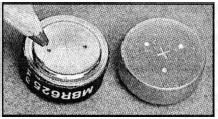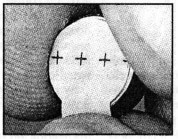Popular Photography
Phototronics
Finally! Wein develops a replacement for mercury cells.
James Bailey
No subject that I’ve written about lo these many years has raised the hackles of so many readers of this column as the imminent demise of mercury button batteries. The reasons are obvious. Many expensive vintage cameras and exposure meters–from Leica CLs to Gossen Lunasixes to Nikon Photomic meter prisms to Konica Autoreflexes–in order to function properly, depend on the steady voltage supplied by mercuric oxide cells. And, as we’ve discovered in testing them, alkaline batteries are a poor substitute, even if they’re the same size and deliver a similar initial output.

Several readers, and many electronics experts, have suggested using zinc-air batteries, the kind often found in hearing aids, as a replacement for mercury cells. Certainly, the zinc-air chemistry offers one of the few viable alternatives to mercuric oxide in terms of delivering steady voltage and having a high energy storage capacity. Also, the voltage level supplied by unmodified zinc-air cells designed for hearing aids is acceptably close to that provided by mercury cells. Indeed, several experimenters, including yours truly, have used them successfully (albeit with jury-rigged adapters and spacers) in mercury-powered cameras and meters.
However, running promising experiments is one thing; producing a commercially successful replacement for mercury cells is quite another. Fortunately, one company, Wein Products, Inc. of Los Angeles, California, decided to take up the challenge. As you’ll soon see, they faced some formidable obstacles.
The main problem Wein’s engineers confronted is that a zinc-air battery starts producing electricity in usable quantities as soon as you remove the adhesive seal from the back of the cell. This lets oxygen into the cell through tiny holes in the back, which feeds the chemical reaction.

The reaction continues to produce current even when you’re not drawing any–but at a somewhat slower rate. As a result, the zinc air button cells used in hearing aids and similar devices have an unusually short life compared with other battery types. Their lifespan is further curtailed by moisture evaporating through the air holes.
Most zinc-air button cells designed primarily for use in hearing aids are well suited to this application. They’re much lighter in weight than mercury button cells, provide a steady voltage output, and have sufficient energy capacity. They also contain far less toxic material than do mercury cells, which makes their disposal more environmentally friendly.
The fact that they can dry out and run down in a couple of months or less is of little consequence when they’re used in hearing aids. Hearing aids draw far more current than do exposure meter circuits, so the cells inevitably run down quite a bit sooner than that. In photo applications, the current draw is so low, however, that zinc-air cells could theoretically last as long as mercury cells.
Conventional zinc-air button cells produce 1.4 volts each. The chemical mix in Wein’s newly developed MRB625’s has been altered, so they put out a nominal 1.36 volts when the cells are activated. Also, the Wein cells have only two air holes, compared with three or four in hearing aid cells, which helps slow down drying out and lets less oxygen into the cell.
According to Wein, the majority of photo exposure meters and cameras designed for mercury cells draw no more than 200 microamperes of current–even in bright sunlight. Thus, not much oxygen is needed to keep the cells working briskly enough to power photo equipment. Since hearing aid cells need to supply over one milliampere (1000 microamperes), they need more air–hence, more air holes.
Wein estimates, on the basis of lab tests and field trials, that a set of their cells should give about three months of service once the seals are removed. They should last several years if kept sealed.
But do the Wein cells deliver power at as constant a rate as mercury cells? To compare their voltage stability, we placed two different post-production versions of the Wein cells, one Rayovac zinc-air hearing aid cell, and a 625 mercury button cell on 200 microampere loads on the lab bench. During two months of continuous current drain, none of the cells’ output dropped more than a few thousandths of a volt. However, the Wein cells dropped only about half as many millivolts as the hearing aid cell did–an impressive performance.

But how well do these Wein cells actually work in exposure meters? To find out, we tested two different pre-release versions in our lab. One type put out about 1.325 volts; the other, about 1.314 volts. Wein will be producing only one of the two types when the new batteries are officially released at the 1995 Photo Marketing Association show. Based on our tests, the difference between them appears insignificant.
In our trials using a Gossen Luna-Pro exposure meter, we got the same readings whether we used brand-new 625 mercury cells, a set of mercury cells that had been in the meter for about three years, or either set of Wein cells. The readings among all four sets varied less than a third of a stop.
Out of curiosity, we also tried a set of Rayovac Pro Line 675A zinc-air hearing aid batteries in the Luna-Pro. We got just about the same readings using these cells as well.
As we mentioned in a previous column (September ’94, page 144), you shouldn’t leave spent zinc-air cells in your camera equipment for more than a couple of months. We’ve been advised by hearing aid battery manufacturers that old cells could leak chemicals out of the vent holes. The risk is said to be greatest if the cells are completely run down.
To check the validity of this admonition, we placed a 675A hearing aid battery, with its seal removed, on top of our desk, for one month. Afterwards, to kill it off, we shorted it out with a bent paper clip for 48 hours. We then removed the paper clip. After a second month on my desk the cell still didn’t leak. Of course, just because this particular cell hasn’t leaked to date doesn’t mean you shouldn’t heed the manufacturers’ advice. After all, these folks have examined and tested more batteries than any of us ever will.
By the way, we were astonished to find that after two months and the paper clip trick, a subsequent test of the hearing aid cell showed that it was still putting out over 1.3 volts. Even more interesting, it pushed the needle of a mercury battery tester far into the green! The meter itself draws about one milliampere when set for testing mercury batteries.
One drawback of both the 675A and the prototype Wein cells we tested is that they’re too small to serve as direct replacements for the most commonly used mercury cells – the 625’s. Both are the same diameter as the tiny 675 mercury button cells.

To help them fit the Gossen Luna-Pro, we fashioned a cylinder of thin cardboard cut from a file card. The strip was ⅜-inch wide. We coated the strip with glue and rolled it into a cylinder ½ inch in diameter on the inside. When the glue was dry, we slipped a pair of cells into the cylinder and put the combination into the meter. We also found it necessary to pry up the battery-compartment lid’s spring a bit to get a better contact with the cells since they’re also a tiny bit shorter than 625 cells. Once we had done these things, the cells stayed in place and worked just fine.
They’re here!
We’ve saved the best news for last. By the time you read this, Wein should be marketing their new cells in the larger 625 size. This will make them much easier to use, without any adaptations needed, in a much wider variety of photo equipment. They’re packaged individually at $5.95 per cell, a relatively small price to pay to keep your costly vintage equipment operational. They’ll also be sold to service centers in packs of ten.
While we haven’t yet evaluated the production versions of any Wein cells, our hunch, on the basis of preliminary testing, is that they should, during their shorter life, work as well as mercury cells in most cameras and meters. They also may be even less prone to leaking than conventional zinc-air cells and may last far longer in photographic applications. As soon as we can get our hands–and measuring devices–on over-the-counter Wein cells, we’ll definitely put ‘em through their paces and report our findings in detail.
In the meantime, herewith some suggestions for potential users. To prevent corrosion, we strongly recommend that you remove Wein or zinc-air cells from your equipment after they’ve been in service for three months or so. In fact, Wein suggests that you can increase the cells’ useful lifespan by removing them from your meter or camera and replacing the peel-off seals if you don’t intend to use your equipment for a few days or longer. This should help keep the cells from drying out. A final energy-saving tip: Don’t activate fresh cells until you actually plan to use the equipment; leave their original seals intact.
It goes without saying that we’re very interested in hearing from our readers about their experiences – both positive and negative – with these new batteries. Just drop a line (snail mail only, please) to Cell Mates, c/o Popular Photography, 1633 Broadway, New York, NY 10019.
